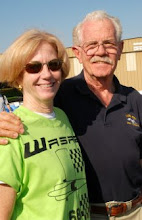Hey Guys,
Below is the report for FLT005 in the GT-400 "Snort".
It was a great flight. Mojave Experimental Flyin is coming up and everybody is talking about records, so we used it as an excuse to get some performance data on Snort. The result was 1.87 ft^2 effective flat plate area.
We also used this opportunity to further qualify an approach we use on Wasabi. So by measuring manifold pressure (MAP) and the speed of the engine (RPM) we know the horsepower that a stock 520 would make in that configuration. The issue is we don't know the efficiency of the propeller, and we don't know how strong the engine is. The solution, as Andy would say is "more data!".
In order to get more data points to backup the assumption that Continental is accurate with their power estimates we use the dive method (see Hoot's report link). If you know the weight of the airplane, you can derive the thrust given by a dive. You already know how much power Continental thinks you should be making. So by summing the two you know how much HP it took to go that fast.
Example: The GT-400 weighed roughly 2400 pounds, so with a 500 FPM descent you are getting energy from gravity at a rate of 36 HP. Add 36 HP to the 165 HP the engine was making and you get 201 HP. Experimentally we found this correlated to a indicated airspeed of 250 MPH. 250 MPH correlates to a dynamic pressure of about 160 pounds per square foot. 206 HP at 250 MPH correlates to 302 lbs of thrust. So 302 divided by 160 is 1.88 square feet of equivalent drag.
This is a little harder with Snort because the airplane is naturally aspirated and we try to keep the flights to about an hour. Without automatic boost regulation the MAP (and therefore power) changes with altitude, and at -2000 feet per minute the altitude is changing pretty fast. There are two options for this you can time your flying just right so that you pass through a particular altitude at the moment you are on condition. Or you can take note of your altitude and MAP when you get stabilized and look up the HP for each pass individually. We did the latter.
The plot below is the summary of the data. The cluster is pretty tight, which almost makes me believe the data!!
Airplanes are cool,
Elliot
3 things worth noting:
1. We made no attempt to compensate for the loss of thrust from the propeller. Typically assumed to be 90% efficient, this makes our findings somewhat conservative.
2. The reason this is a more difficult test with Wasabi is the Continental reference material does not typically go to the engine RPM that we are running, which requires making assumptions.
3. Below is a picture of the panel on Snort. Note on the Manifold pressure gauge (top right) that ~1/8" = 1 INHG. This resolution is a little coarser than I would like for this kind of testing.






















